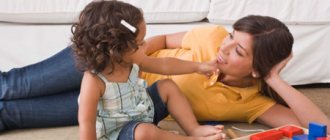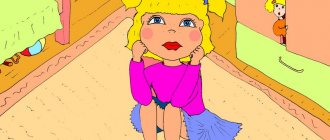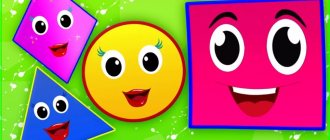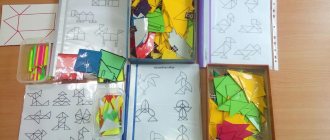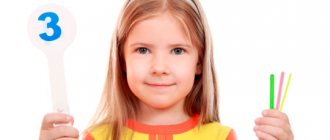Very often, parents, when trying to give their child a first idea of mathematics, focus exclusively on ordinal counting or memorizing numbers. Naturally, both are useful activities, however, if you really want to teach your child to count, then you need to introduce him not to numbers, but to quantities , and not just memorize counting to ten with your child, but help him understand the spoken meanings and develop mathematical thinking . For a child, the words “Four apples” should not be an empty phrase; the child should clearly understand how many apples it is and understand that, for example, four is more than two.
Mathematics for kids. Basic principles
The math games that I want to talk about in this article are best suited for children 2-4 years old (and some even earlier). The main goal of these games is to teach the child to visually recognize a number, to understand which is larger, which is smaller, which are the same, which quantity corresponds to each number, and what will happen if you add one more to three apples. I would like to note that these are games, not lessons. Children at this age will not like it too much if you constantly torture them with questions like “Show me the number 3” “Tell me how many sticks are there?” They need to be interested by unobtrusively adding math problems to everyday story games. I notice the highest interest in my daughter when her favorite toy personally tells her about her problem and asks her for help (I’m talking about the toy, of course).
Don't try to play with big numbers right away! It is enough to limit yourself to 4-5 games. Agree, it is much more attractive to help a child master various operations with numbers not exceeding the number 4 and develop mathematical thinking than to simply learn to count to ten without knowing how to operate with each of these numbers. A child who has mastered operations with small numbers will then easily transfer his skills to large numbers.
So, math games for kids:
First acquaintance with numbers: when and where to start
You can start introducing your baby to numbers at the age of 1.5-2 years. But it is too early to expect significant mathematical success from a small child, although children quickly understand the difference between the concepts of “one” and “many” even at an early age.
Briefly about the stages of a child learning to count - in the table:
Trying to teach a child to count too early is not worth it because of the differences in children's thinking from that of adults. There is such a thing as Piagetian phenomena, proven by the French psychologist Jean Piaget.
The psychologist has proven that children under six years old cannot treat counting abstractly, considering a mathematical operation to be correct only in the present tense and precisely with those objects that an adult shows. For example, a child under six years old will be convinced that if he takes the apples to another room, or replaces the apples with pears, the number of objects will change.
The best way to teach children to count is in 4 stages:
- At 2-3 years old it is enough to teach a child to understand the difference between “little” and “many”.
- At 4-5 years old, it’s time to learn to count concrete, not abstract, objects within 10: candy in a vase, plates on the table, books on a shelf.
- At 5-6 years old, a child can be taught to count to 10 and 20, and show how numbers look and are written. At the same age, the baby is already able to understand the terms “more and less,” adding the right amount to objects or, conversely, removing the excess to achieve equality (for example, arranging toys in equal piles).
- By the age of 6-7 years, the child is ready to learn to count to 100, and add and subtract numbers up to 10.
We study the concept of “The same amount”
Here are a few examples of our very first games with quantities (we played them at the age of about 2 years):
- We place 2-3 toys at the table, inform the child that today is one of them’s birthday, so all the guests need to be fed. To begin with, we count together how many guests there are and with the words “So, there are only 3 guests, which means we will need 3 plates too,” we count out three plates with the baby. We arrange them for the guests, check that there is enough for everyone, which means that there are as many as there are toys. Similarly, you can give tasks for distributing spoons or chairs for toys.
- Then, in the voice of the doll Masha, we say, “Can I please have 3 mushrooms?” We count out 3 mushrooms for Masha. Then we reason that the frog should be given the same amount so as not to offend him. We count out 3 mushrooms for him too. The concept of “ the same amount ” was re-established.
In the game, you can use any available counting material (cones, buttons, counting sticks) or purchased ones (mushrooms, carrots, tomatoes).
- You don’t have to limit yourself to just the theme of tea drinking; mathematics can be added to any role-playing games. For example, put the same number of houses as there are animals, draw the same number of berries as there are hedgehogs in the picture, etc. The main thing is to harmoniously weave the task into the plot of the game, telling the story that the animals were left without housing, etc.
Comparing "More-Less"
- Continuing the theme of the birthday toy, we lay out 2 mushrooms for one of the guests, and 4 for the other, together we think about who has more and who has less. First, we let the child try to determine by eye; if he makes a mistake, we recalculate together.
- If the child is already good at comparing similar objects, you can offer him a more difficult task : put in front of him 2 different numbers of objects of different sizes, for example, buttons. For example, we put 3 large buttons and 5 small ones and ask which one has more. At first, kids usually get confused, pointing to large buttons. Your task is to explain that in this problem you are not comparing the size, but the number of buttons.
How to teach counting to 10
You can teach your child to count to 10 before the age of five, or, if necessary, at an older age. The main conditions for successfully teaching mental counting to 10 are a child’s good vocabulary and interest in numbers.
How to teach your child to count to 10:
- focus on numbers that you already use in everyday situations, for example: “You are four years old now, and will soon be five years old,” “It’s time to get up, it’s already seven o’clock”;
- show images with different numbers of objects within 10: illustrations in books, cubes, your own drawings;
- educational videos and cartoons on the relevant topic will help you quickly remember the sequence of counting to 10;
- connect elements of mental arithmetic: teach your child to use an abacus - often children quickly master counting within 10 by practicing with abacus abacus, or even with classic wooden abacus;
- use an element of the Montessori method: the famous teacher successfully taught counting to children aged 3-6 years, regardless of their initial abilities, using the most visual practical material - money (Maria Montessori considered money exchange exercises to be the most effective activity for understanding counting).
When sending your child to school, take care not only of his intellectual preparation. After all, at school the child will encounter a whole new world. Some children have a hard time with the adaptation period. The “Where are my children” application will help you make sure that your child is not bullied by peers or teachers, that he has no problems and that he is safe!
Board games
Board games with cubes and chips are one of the best and most interesting ways to practice ordinal counting with your child. In addition, by constantly counting the same number of dots on a cube, the baby learns to recognize the number without counting, which is also very useful and will help in the future to easily operate numbers in the mind.
Taisiya and I started playing board games at 2.5 years old, at this age she could already understand that you need to play according to the rules, there is a sequence of moves, etc. I wrote in detail about all our first board games here. And here you can download a walking game made especially for kids.
Initial steps to teach children to count
So, you have decided to start teaching your child to count. There is no need to wait for the right moment or convenient conditions - exercise wherever you can: walking in the yard, playing in the sandbox, being at home, walking around the store, etc. The basics of counting can be taught without any preparation.
First you need to teach your child the simplest number series, consisting of five digits. Remember that almost everything in life can be calculated. Watch a cartoon - count the number of characters on the screen, dress your child for the street - draw his attention to the wardrobe, and tell him that he can only wear one coat, that he has two legs, but only one pair of shoes can be put on them.
When you read a book, linger longer on the illustrations, count the number of elements depicted on it, animals, people, houses. When you walk down the street, count the dogs and cats running by, the cars passing by. By doing this every day, and at every opportunity, your little miracle will definitely learn the order of counting. In addition, auditory and visual memory, as well as attention, will develop.
When a child gets acquainted with numbers and counting, he must understand that he is performing some actions or tasks not because you ask him to do it, but because it will be useful to him. Show your child the practical benefits of being able to count, and then handing out two cookies to everyone at home will not be difficult for him.
Involve your child in household chores as often as possible. For example, when you are going to dinner, ask him to give you a specific number of glasses, plates or cutlery. When cooking, explain that preparing a particular dish requires a specific amount of ingredients, otherwise the dish will not work.
If you are wiping the dust on the bottom shelf, draw a number with a rag and ask the young mathematician to tell you it. You can even write an example and then present its solution. Walking around the store will also be a great way to exercise your baby. Make a grocery list with your little one, clearly saying the quantity of everything you need to buy and flexing your fingers. Let the baby try to remember the information, at least a couple of lines.
Already in the store, remind your tiny assistant that he must help you, and refresh his shopping list in his head. This will activate his brain centers, which means he will learn to count faster. In addition, you will show your baby that you cannot do without him, and, realizing his importance, he will be more eager to help you.
And remember one important rule: all your actions will not bring any results if you do them randomly. When it comes to learning, regularity and persistence are important. By working with your child systematically, coming up with new forms of basic everyday learning to count, you will achieve good results.
Now let's get acquainted with more systematic methods of teaching children to count, namely, with tasks for the little ones in pictures and children's educational games. Let's start with the pictures, because... they are the easiest to work with.
Simple operations with objects: addition and subtraction
No, of course, I won’t write here that it’s time to solve the examples. We will simply unobtrusively, during the game, give the child an elementary and very simplified idea of such mathematical operations as addition and subtraction. Everything is just in a playful way! If the child finds it difficult or does not want to count, we simply pronounce the conclusion from the game situation ourselves : “There were three candies, we ate one, there are two left.” Here are some examples of games with which you can train your child’s mathematical thinking (let me remind you that so far we only use the smallest numbers in our games - within 4-5):
- We take some toy and go with it into the forest in search of berries. For example, we played with a cat. Walking around the room, we found berries and pebbles of two colors under chairs and tables. Well, at the end they counted: “How many orange berries did the cat find? Three. How many yellow ones? Two. Now let's count how many berries he found. Five. It turns out that we collected 2 yellow berries and 3 orange ones, for a total of 5!”
- The fixies gathered to repair the chair. They have 3 bolts. Let's calculate whether each fixie has enough bolts. How many more bolts do I need to find?
- We transport the cubes in the car to the construction site (let's say 3 pieces). During transportation, one cube falls out. We count how many cubes are left.
- We give the bear three candies, he eats two. We count how much he has left.
- It is very interesting to play the so-called “hide and seek” game. For example, we draw four apples, then cover one with our palm, how many are left? Then we close two, etc.
How to teach counting to 100
When a child learns to count to 20 without missing a beat, it’s time for parents to help their son or daughter master counting to one hundred. Try teaching your child to count to 100 this way:
- Tell your child that numbers greater than ten used to be called “two tens,” “three tens,” “four tens,” and so on. Later, the word “ten” was shortened to “twenty” and the familiar “twenty”, “thirty”, “fifty” appeared. Exceptions to remember: "forty" (meaning "very many") and "ninety" (meaning "nine to a hundred").
- Practice memorizing tens in the correct order from 10 to 100: 10, 20, 30, 40, 50...
- Once you remember the correct sequence of tens, move on to units. Explain to your child that the numbers from 20 to 100 are not consecutive - there are always ones between them: 21, 22, 23, etc. Children who have mastered counting to 10 and 20 quickly understand and remember the sequence of counting to one hundred.
- Ask your child to learn numbers gradually, one ten a day: from 10 to 20, from 20 to 30, and so on in order until 100.
- Practice activities in game forms. Encourage children's love to look for inconsistencies and errors: deliberately skip a number in a series up to 100, and ask the child to find the “missing” number - such logic games help to quickly memorize counting up to 100.
Having mastered the numbers, proceed to gradually study the multiplication table. We have collected in one place and talked about the most effective ways that will help your child easily cope with this task!
Number composition
It is very useful to break down numbers into their components with your child (for example, 3 is 2+1, 1+1+1, 3+0). This will help the child with counting in the future. Game options:
- Look, you and I have three apples, let's divide them between the bear and the bunny. We will give one apple to the bunny, and two to the bear. Try to redistribute the apples between the toys in different ways, showing different options for decomposing the number.
- You can attach several clothespins to a hanger, place small toys along the edges and redistribute the clothespins between them, imagining that they are, for example, candies. It turned out to be an excellent replacement for the usual boring accounts. Another option: you can put the bagels on a ribbon and redistribute them in the same way, saying who got how much.
Getting acquainted with numbers, establishing the relationship between numbers and quantities
Once your child has some idea of quantities, you can start introducing numbers. Now, having calculated something, you not only name the number, but also show the corresponding figure. Here are some more options for math games:
- We build towers from construction sets or cubes of the appropriate size;
- We attach a suitable number of clothespins-hair (HERE YOU CAN DOWNLOAD our head templates);
- We select dominoes with the required number of dots (to diversify the game, you can invite your child to transport dominoes to numbered houses on a typewriter);
- We lay out tracks from counting sticks and select the appropriate numbers - the length of the resulting tracks will help the child understand which number is larger;
- We put the required number of matches into the numbered boxes;
- We put the required number of cubes into the cars with numbers (the cars can be drawn on paper);
- You can also use ready-made solutions, like this game “Numbers” (Ozon, Labyrinth, My-shop)
or insert frame (Ozon, My-shop, Read)
Repeating numbers
To reinforce numbers, games will be useful in which the child needs to find identical numbers and combine them. For example, you can match houses to toys by numbers, place cars in numbered garages, etc.
Or play the math game "Train Engine" . To do this, draw a steam locomotive on paper or build a steam locomotive from a construction set, numbering the cars. Each passenger, as they approach, will call out the number of their carriage, and let the child seat everyone in their seats.
Books with poems about numbers, like Marshak’s “Merry Counting” (Ozon, Labyrinth, My-shop), will also help in memorizing numbers. We were lucky and the numbers in the book were exactly the size of our soft numbers, so we overlapped them as we read.
I also really like “Merry Count” by N. Vladimirova (Ozon, Labyrinth, My-shop), I wrote about it here before.

